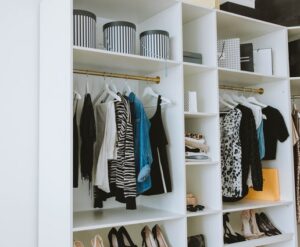by Jayme | Dec 15, 2021 | Clutter, Managing Time
By: Jena Ehlers, The Wellness Resolution
 Disorganization and clutter can affect you both mentally and physically. Having lots of clutter and being disorganized creates more stress in our lives. It can cause anxiety. Too much clutter can also cause troubles sleeping, poor eating choices, or even make it hard to dust causing allergies.
Disorganization and clutter can affect you both mentally and physically. Having lots of clutter and being disorganized creates more stress in our lives. It can cause anxiety. Too much clutter can also cause troubles sleeping, poor eating choices, or even make it hard to dust causing allergies.
How an Unorganized Space Creates Anxiety
After an exhausting day, it can be hard to relax when you see piles of papers, piles of boxes, surfaces cluttered with junk, clothing piled up, etc. You might not consciously feel anxious when you see the clutter, but you could be feeling it subconsciously. Just think about how you feel after you have cleaned your kitchen and everything is neatly put away. There is a sense of calm when you start cooking and nothing gets in your way.
I have noticed when I make sure to clear all the clutter on my coffee tables, end tables, fold blankets, and place all the pillows neatly on my couch before bed, I feel this sense of calm when I see my living room space in the morning. When I don’t my mood is less uplifting.
Harms Your Productivity and Focus
It can be harder to concentrate on one project at a time if you are not organized. Not only with not being organized with your work priorities, but just seeing clutter around you can be a distraction and make it harder to focus and remember things.
Sabotages Your Time
When you are in a rush to make a meal, find the perfect outfit for the day, and get out the door in the morning, being organized is a huge time saver! Just the thought that you might be late for work or another activity can create some anxious feelings. Being organized will help you make more efficient plans and save you time.
Anxiety from Items that Don’t Fit Your Space or Lifestyle
Items that don’t fit with the style of your living room, clash with the color palette you are trying to achieve, take up too much space, or remind you of a person you used to be, should be decluttered. These items can make you feel less happy, and your home should be a place that best represents you. The current you, not the past you. These items can also create unnecessary anxiety, and your home should be the place where you feel the most comfortable.
Items that Bring Bad Memories
Clutter could bring up bad memories either on a conscious or subconscious level. Maybe you have an item in your house that reminds you of a difficult time in your life, an item a friend gave you that you no longer speak to, or just an item that represents a former you. Seeing that item regularly could cause sadness, anger, or anxiety. So make sure to declutter items that no longer bring you any happiness, even if they are really unique or expensive.
At Top Shelf Home Organizing, we love to help busy households get organized. If you are looking for guidance on getting your home organized, reach out to Jayme.
by Jayme | Nov 1, 2021 | Busyness, Clutter, Organizing
 Decluttering is one of the first steps to an organized home. The emotions that emerge when sifting through items in your home can overtake your motivation to declutter. We all experience emotions when working through items acquired through our life experiences. Hope, fear, guilt and emotional attachment may prevent us from decluttering our homes. Identifying, understanding, and overcoming these emotions will help you create the peaceful home you desire.
Decluttering is one of the first steps to an organized home. The emotions that emerge when sifting through items in your home can overtake your motivation to declutter. We all experience emotions when working through items acquired through our life experiences. Hope, fear, guilt and emotional attachment may prevent us from decluttering our homes. Identifying, understanding, and overcoming these emotions will help you create the peaceful home you desire.
Here are some key areas to consider to help overcome these strong emotions.
Setting Small Goals
Have you started to declutter in the past, but the project was too overwhelming? When emotions arise, cutting the clutter can be nearly impossible to tackle. Breaking the process down in steps or a method can make the project manageable and reduce overwhelm. Instead of telling yourself you are going to organize the basement this weekend, set the goal of gathering one category of items. Getting all items together is a task that is clearly defined and does not bring on the overwhelm of the entire organizing process.
Gathering tools, pants, or pots and pans feels much more manageable than getting an entire room organized in one weekend. Once a category is gathered, set the next goal of sorting the category. Dividing the items into: need/love, don’t need/dislike, and might use/its okay categories is a task that can be completed in a reasonable time. Breaking down the individual tasks in an organizing project will help reduce overwhelm.
Letting Go
The things in our home and life arrived because of a life event. Revisiting these items may bring back memories. A college backpack, an engraved pen set, wedding dress, handwritten notes and cards, artwork, sporting goods, or tools and crafts were acquired at a time of life when there was an accomplishment, celebration, or a life change. It was a big time in your life. An array of emotions may surface when approaching these things making you feel the need to keep the items. Understand these items are not who you are. Your life experiences have shaped who you are today, not the stuff. Letting go of items will not change who you are, what you have experienced, or what you have accomplished.
Fear
The emotion of fear prevents us from decluttering our homes. We keep items because they offer a sense of security. Fear may exist because you feel you may not have the resources someday to purchase the items or the items may not be available.
The first step in overcoming this fear is understanding if you will even need or use the item someday. You may be hanging on to hobby items you will not have the time or physical ability to use again, but fear if you get rid of them, you may not have the resources to purchase them again. You may have a pantry full of expired food because you fear you may not have the resources someday to buy food. You may fear you will hurt someone if you donate the wedding gift they gave you. Understanding why you are afraid of purging the things in your home can help you overcome the fear and be realistic about what you keep in your home.
Would You Buy It Today?
Ask yourself if you would buy the item today. This question is great when you are decluttering household items, personal care items, and clothing. If you were to make a decision on whether to purchase a particular item right now, would you? Would you purchase that kitchen gadget, lipstick, or clothing item you have in your closet today? You may have truly enjoyed the item at one time. Maybe you believed the item would make you more efficient in the kitchen. If your answer to this question today is anything but “yes,” the items do not have a place in your home.
At Top Shelf Home Organizing, we love to help busy households get organized. If you are looking for guidance on getting your home organized, reach out to Jayme.
by Jayme | Sep 27, 2021 | Organizing, Wardrobe
 The season change is a great time to assess and change out your wardrobe. Here are three categories the experts use to make this event as fun and simple as possible.
The season change is a great time to assess and change out your wardrobe. Here are three categories the experts use to make this event as fun and simple as possible.
Existing Season
Filter through your wardrobe for the current season before packing it away or moving it to the back of your closet. Pull all clothing items out and group them by categories. While going through each item, decide if you enjoyed the item this past season or did not. There will be items you simply did not wear or did not enjoy wearing. Those can be donated. Clearing out items that no longer fit, you don’t like, or are worn out will make wardrobe changing now and the next season much easier.
Wardrobe Staples
Your wardrobe has items that transfer to multiple seasons. You will want to pull all these items out and sort them by category. Remove items that do not serve you anymore and pass them on. Take note of any staples that need to be replaced. Undergarments, socks, athletic wear, shoes, and jeans all fall into this area. Seasonal wardrobe changing is a good time to go through and organize your clothing staples.
New Season
Bringing out the clothing for the next season should feel fun and exciting. You may have stored these items in the basement, extra closet, or the back of your closet. These items should also be sorted by category. If there are any items you did not wear or did not want to wear the last time they were in your closet, donate them. Some clothing items might need to be tried on to ensure a good fit and a fabulous feeling when you wear them. Take note of any items that will need to be replaced.
Last Steps
Once all three categories have been sorted, organized, and purged, they can be combined into your closet and drawers. Off-season items can be laundered and neatly packed away. All items that are put back into your wardrobe should be items that fit well, make you feel fabulous, and provide good function.
When shopping for new items use your notes on items that need to be replaced to ensure you stay within your budget and have good focus. Your closet will have a fresh feel and coordinating your daily outfit will be fun and painless.
If changing out your wardrobe brings stress, we would love to help. Check us out at topshelfhomeorganizing.com or call Jayme at 262-373-9416.
by Jayme | Aug 23, 2021 | Cooking & Kitchen, Organizing
An organized kitchen is our hopes and dreams for preparing meals efficiently. Setting up the framework of your kitchen can help you be the best chef or short order cook you can be. Here are some tips from the organizing experts.
 Kitchen Items Only
Kitchen Items Only
Your kitchen is prime real estate when it comes to your home. You need to protect the boundaries and only allow kitchen items in the kitchen. The drawers labeled, “office,” “toolbox,” “junk,” or “crafts” can serve a new purpose in your kitchen. Place those items in their respective areas of your home; the office, the workshop/basement/garage, the trash or the craft room. This extra space will be a functional space in your kitchen.
Location
Where your items are located will determine how quickly and efficiently you can move around your kitchen. Everyday plates, glasses and flatware located near the sink or dishwasher will make putting dishes away streamlined. Occasional dishes and glasses can be located on the perimeter. Items that are only used annually or for very special occasions can be placed in a storage area in the basement or garage if space in your kitchen is limited. Small appliances that don’t get used can be donated. Those items take up a lot of room.
Pantry
Whether your kitchen has an official pantry or not, keep food items together versus spread around your kitchen. It will help you keep an accurate inventory of what food you have. Stashing food randomly throughout your cabinets will cause you to lose track of what you have. Identify an area of your kitchen where you will keep food.
Minimize
Minimize the items you have in your kitchen. Duplicates of utensils, cookware, storage containers and small appliances will cause overcrowding in the limited space. Identify the most practical items and place the extras into storage or remove them from your inventory.
There is no doubt a kitchen is one of the most challenging spaces in a home to organize. Establishing a framework for your kitchen and keeping only kitchen items in the kitchen will help maximize your kitchen’s potential. It will also help you be as efficient as you can be. If creating an organized kitchen is overwhelming to you, Top Shelf Home Organizing can help. Contact Jayme to see how Top Shelf Home Organizing can help you.
by Jayme | Jul 21, 2021 | Clutter, Organizing, Saving Time
 For many of us, getting organized is manageable but maintaining the organization is a challenge. Whether you spend your weekend binge organizing or outsource your organizing projects to a professional, the organization systems need to be maintained. As a busy mom of four, dog mom of two pooches, wife, and business owner, I want to share my 10 favorite personal tidy tips that help me keep sane when the day is hectic.
For many of us, getting organized is manageable but maintaining the organization is a challenge. Whether you spend your weekend binge organizing or outsource your organizing projects to a professional, the organization systems need to be maintained. As a busy mom of four, dog mom of two pooches, wife, and business owner, I want to share my 10 favorite personal tidy tips that help me keep sane when the day is hectic.
- Make Your Bed
Make your bed right when you crawl out.
- Put Your Stuff Away, Right Away
Remember how it takes time and resources to get organized? Now you need to put your things away to keep your home organized.
- Make the Rounds
Make the rounds through your house to collect and put away miscellaneous items daily or twice daily.
- Run the Dishwasher
Empty the dishwasher first thing in the morning. This will start your day with a clean slate in the kitchen. Load the dishwasher throughout the day with soiled dishes. Run the dishwasher nightly. Repeat this process every day to prevent a dirty dish pile-up.
- Clean-Up as You Go
Wipe the countertops after each meal. Wipe the bathroom counter and faucet after you brush your teeth. Squidgy the shower walls and door after a shower. Wipe spills and splatters as they happen.
- Have a Schedule
Have a day scheduled for larger tasks, even if you cannot dedicate a full day to these tasks. Focusing time on just one task will get it done more efficiently than juggling all the tasks unsuccessfully at one time.
-
- Grocery day
- Meal prep day
- Laundry day
- Cleaning day
- Additionally, use a deep clean schedule to help rotate through deep cleaning areas of your home. Schedule one area per week.
- Think Tidy When You Walk Through the Door
-
- Leave your shoes at the door
- Put your bag on its hook
- Keys go where they belong
- Leave Nothing on the Floor
-
- Keep toys, papers, blankets, and dirty clothes off the floor
- Hang up clothes you will re-wear right away
- Place dirty clothes go into the hamper
- Towels get hung on the hook
- Toys get put away when not being used
- Take Out the Trash
Take out the trash when you leave the house for the day. This will keep odors out of your house while you are gone. It will also feel good to see an empty garbage can when you get home from a busy day. Don’t forget garbage collection day. All trash and recycling need to go out on trash day.
- Deal with Mail Daily
Collect, sort, purge, and file mail daily. Removing the junk mail daily will make your mail opening day more manageable. File important mail in one location so it is gathered together and ready when you need to open it. Open the mail when you are ready to address, pay, and file it.
Establishing and maintaining a routine will help your home stay tidy. At Top Shelf Home Organizing, we love to help busy households get organized. If you are looking for guidance on getting your home or office organized, reach out to Jayme.
 Disorganization and clutter can affect you both mentally and physically. Having lots of clutter and being disorganized creates more stress in our lives. It can cause anxiety. Too much clutter can also cause troubles sleeping, poor eating choices, or even make it hard to dust causing allergies.
Disorganization and clutter can affect you both mentally and physically. Having lots of clutter and being disorganized creates more stress in our lives. It can cause anxiety. Too much clutter can also cause troubles sleeping, poor eating choices, or even make it hard to dust causing allergies.



